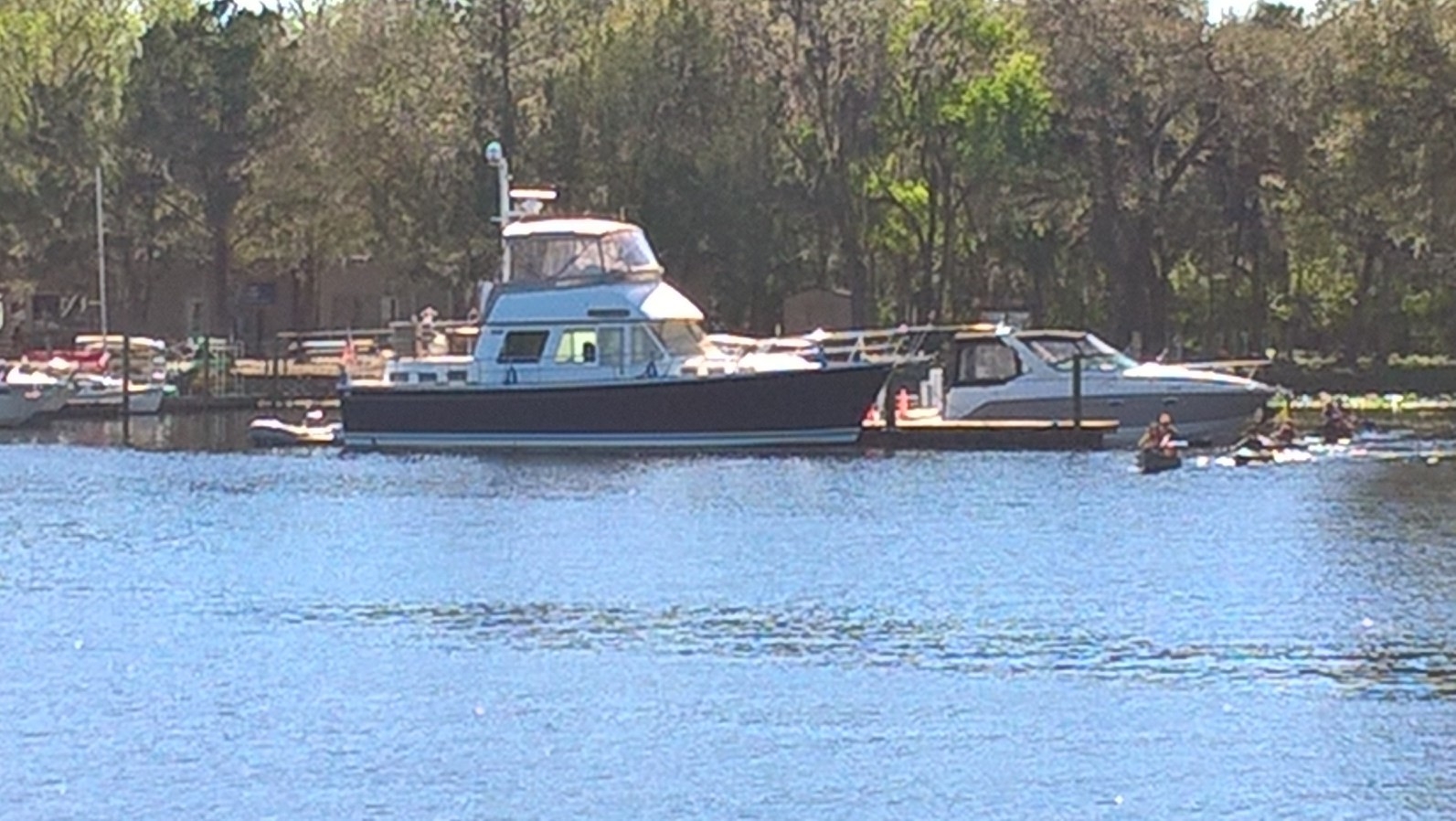does this look normal?
 rasbury
Member Posts: 8,763 ✭✭✭✭✭
rasbury
Member Posts: 8,763 ✭✭✭✭✭
I have had trailer issues,...many posts and questions on it. No real experience working on a trailer, you would not think it rocket science and I'm sure it is not, but, to me getting it right while not wanting to get off my wallet has been tough!
@212rowboat has provided a lot of info and I'd say he is probably our resident expert on trailers and he has me looking at stuff I would never have thought about. So, one thing was looking at the suspension itself when the boat is loaded. The first attached picture with the boat on the trailer got me thinking I needed to move the boat forward to level out the front and rear suspension. Not sure what that center part is called, but, you can see that it does not look level. I was looking at the trailer with the boat off the trailer expecting it to look more level but as you can see, it is worse. First thought was to pull it all apart and see if something is stock not allowing it to level out as 212 had suggested. My other thought was, in setting up the trailer suspension, might it be intentionally be set up that was so that when the trailer is loaded properly, it levels out assuming there is perhaps more weight towards the back of the boat while it is being trailered? And lastly, a picture I took a couple weekends ago while we were out at a place Hootoon Island. The water is so low in the river I had to lift the motor and get pulled by my ropes to get into the slip- how that big ol boat gets around I have no clue. The marked channel

 is 11 feet plus but around the banks, it is very low right now. St. Johns River. The picture of the boat on the trailer, it's hard to see but that part between the two tires usually is a bit more off level than I see in this picture but when you take the boat off, wow! Is it supposed to be that way?
is 11 feet plus but around the banks, it is very low right now. St. Johns River. The picture of the boat on the trailer, it's hard to see but that part between the two tires usually is a bit more off level than I see in this picture but when you take the boat off, wow! Is it supposed to be that way?
@212rowboat has provided a lot of info and I'd say he is probably our resident expert on trailers and he has me looking at stuff I would never have thought about. So, one thing was looking at the suspension itself when the boat is loaded. The first attached picture with the boat on the trailer got me thinking I needed to move the boat forward to level out the front and rear suspension. Not sure what that center part is called, but, you can see that it does not look level. I was looking at the trailer with the boat off the trailer expecting it to look more level but as you can see, it is worse. First thought was to pull it all apart and see if something is stock not allowing it to level out as 212 had suggested. My other thought was, in setting up the trailer suspension, might it be intentionally be set up that was so that when the trailer is loaded properly, it levels out assuming there is perhaps more weight towards the back of the boat while it is being trailered? And lastly, a picture I took a couple weekends ago while we were out at a place Hootoon Island. The water is so low in the river I had to lift the motor and get pulled by my ropes to get into the slip- how that big ol boat gets around I have no clue. The marked channel


 is 11 feet plus but around the banks, it is very low right now. St. Johns River. The picture of the boat on the trailer, it's hard to see but that part between the two tires usually is a bit more off level than I see in this picture but when you take the boat off, wow! Is it supposed to be that way?
is 11 feet plus but around the banks, it is very low right now. St. Johns River. The picture of the boat on the trailer, it's hard to see but that part between the two tires usually is a bit more off level than I see in this picture but when you take the boat off, wow! Is it supposed to be that way? Best Answers
-
 212rowboat
Member Posts: 2,593 ✭✭✭✭✭
212rowboat
Member Posts: 2,593 ✭✭✭✭✭

the axle floats- where the eye of the leaf pack bolts through that floating shackle block should be the same on both sides... you have the float pivot in the center. then the leaves attach on either side, either high or low. if it is the rear leaf pack attached low on the floating block, it should be attached low on the other side too...
but the shape of the leaf pack appears, in the pic, to be bent- though it may not be either... it's been my experience that there is no proper orientation of trailer leaves- and the other sides don't seem to have that sweeping bend (it doesn't look creased)... I may be wrong, but that looks like the kind of bend that happens NOT under shock or specific event, but after resting in the same position over an extended period of time- known as 'falling'. i had this happen to leaves on an old dodge i had- they took on an S shape over the axle and had a similar 'falling' look to them right next to the shackle. -
 212rowboat
Member Posts: 2,593 ✭✭✭✭✭
^ BD is all over it... I don't even need to contribute...
212rowboat
Member Posts: 2,593 ✭✭✭✭✭
^ BD is all over it... I don't even need to contribute...
that piece of square tube that floats on a center bolt has a bolt on either side of it. the bolts on either side run through the eye of either spring.
if you were to lay that floating block on a level surface, you'd find that one of those eye bolts is drilled at seven oclock, where the other is at one oclock. if they were at three and nine, the leaves wouldn't fit. because that floating block pivots on that center bolt, it provides an inch or two difference closer or further away and so the leaf pack can fit. if that floating block was level, the leaves wouldn't fit. because the holes in it that allow you to shove a bolt through and thread the eye on the leaf pack are not on the same plane, and the block pivots on it's center, it provides a variable allowance for the leaf packs to fit. the back (other eye of either leaf) shackle is fixed. it can't swing forward or back in that design.
you're thinking, i'd wager, in terms that the trailer frame tells the axle what to do... it doesn't... the axle is alive and the frame (and therefore boat when loaded) is just along for the ride. when you encounter contours on the road and one tire dives that floating block reacts- falling or climbing through it's arch which is in reaction to the axle/wheel falling or climbing in it's vertical arch. when the leaves are compressed, depending on which wheel it is- that block flips position like a seesaw, allowing the wheel behind it to meet the obstacle in a position better suited for negotiating it. it's a clever design i'm sure evolved into existence....
if you understand that^, then understand this:
on the opposite side of the axle (drivers side: passenger side) there is a matching floating block. now that you've mapped the one in the picture and know that one axle is attached at the seven oclock pin and the other at on the one oclock pin, make sure they're the same... example: REAR axle's leaf pack is attached to the floating block on the 7 oclock pin on the DRIVERS side, make sure the REAR axle is attached to the seven oclock pin on the PASSENGER side, too.
this is important for stability.
explanation:
again, the axles are live- the frame and boat (if loaded) are along for the ride. the ONLY place the axle is attached to the frame are through those leaf packs/Ubolts... the ONLY place the leaves are attached is through the shackles... the axle moves and through the medium of suspension, the load (frame and boat) ISN'T SUPPOSED to react AS MUCH... it's supposed to be dampened via the suspension and the suspension IS the leaf pack AND that floating block.
those axles are solid, meaning one piece. when one side compresses the other is driven deeper into the ground, and which creates roll side to side on the attached frame exaggerating the impact and making the load feel unsteady. when running dual axles that may be enough to pitch you over center on a tall load. that would suck. to compensate, that floating block is present to allow one axle to PREPARE for the impact the other axle encountered- providing stability when you need it most. whatever obstacle the leading axle's wheel encountered (say a pothole) the other axle/wheel is prepared for by already diving into the hole (instead of falling) to hold the weight of the load steady.
makes sense?
I've types a friggin' lot, again.....
listen to me... I've said this before... I'm going to again:
get rid of those axles. get THREE axles that are friggin ROUND and not that cheesy 2" diameter square crap... THREE ROUND 4" axles with hubs at least six lugs (up to and including 5200# axles). DUMP the leaves- get TORSION AXLES.... if you don't want to spring for the three, get two 7200# torsion axles and replace the ones you have. as much as you trailer I'm surprised you haven't wiped the eff out by now with catastrophic failure on those square things. your boat is heavy duty.. those axles aren't. Ask around... you can find them cheap as replacing the leaves. it will take you all of two or so hours to swap them out, and this crap will be behind you. torsion don't fall apart due to corrosion, and you don't require a floating block because the torsion will allow the wheel to drop in without altering the yawl of the other side. DO IT.

Answers
The exception is if that end of the 'bent spring' is actually a slipper connection (floating) and not bolted thru a bushing like the opposite end.
PC BYC, Holland, MI
PC BYC, Holland, MI
second pic, the rear leaf spring where it is shackled- appears bent.
that floating shackle has a high/low leaf eye bolt.. in the pic the leaf pack on the rear (to left) attached to the low point. the only concern with it is that the opposite side have the same orientation- meaning the rear leaf on both sides mounts to the low eye bolt.
in the pic, it appears that leaf has sustained a bend from the top leaf to the eye.
PC BYC, Holland, MI